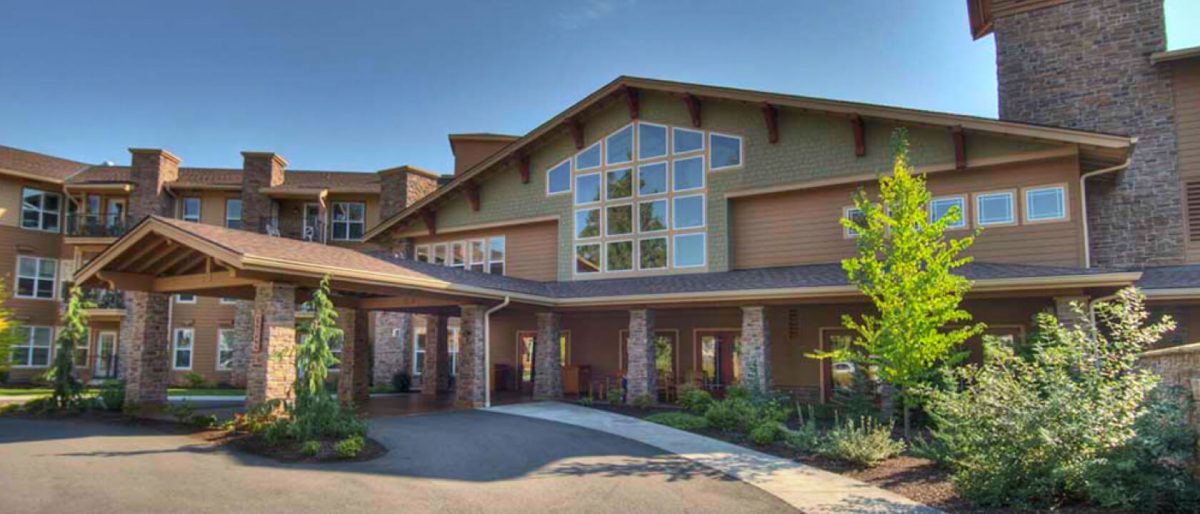
They told him they wanted a “convenient and congenial home” where they could live out their later years in community and with respect without becoming a burden on their families. The Reverend Doctor Stanley Logan, pastor of Mason Methodist Church in Tacoma, shared this dream at the 1943 Annual Conference of the Methodist Church. The following year, the Annual Conference approved a special committee recommendation to form the first Methodist retirement home in the area, designating 15 people as the first Board of Trustees. Articles of Incorporation were signed one month later creating Wesley Gardens, known today as Wesley.
Building Interest
To promote the new project, 5000 pamphlets were printed and distributed throughout the state. Titled “Wesley Gardens, a Dream That Really Is Coming True,” it stated that it would be “something new and different…not patterned after any other place or institution of which we know.”
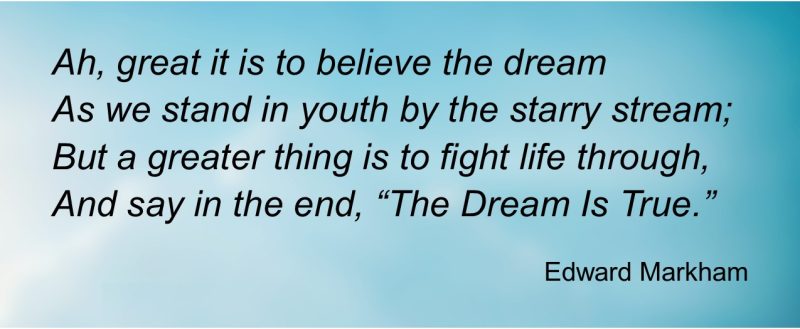
The trustees set out to find 20 acres or more “near a prominent city and shopping; near a church; reasonably good soil; a fine view, preferably marine; and with good transportation.” After much searching and discouragement, Dr. Logan decided to take a drive through Des Moines. There, he “spied a blueberry field on an attractive slope.” He purchased a total of 35.5 acres from 3 different families with adjoining property for a whopping $51,000.
We’ve heard stories of early gardeners sharing their produce with the kitchen and raising livestock and poultry where the blueberry bushes once thrived. Wesley Gardens was where families came to share meals or play on the expansive lawn overlooking Puget Sound. Children became adults who retired and moved themselves to Wesley Gardens or Wesley Homes or Wesley. All because of the good experience had by their parents, grandparents, aunts, and uncles.
Starting in 1949, the first residents built their own homes, later called Cottages, on the Des Moines property. The south wing of Wesley Gardens apartments opened in 1954 followed by the north wing in 1957. This provided a place for Cottage residents to move when they wanted more services or needed care.
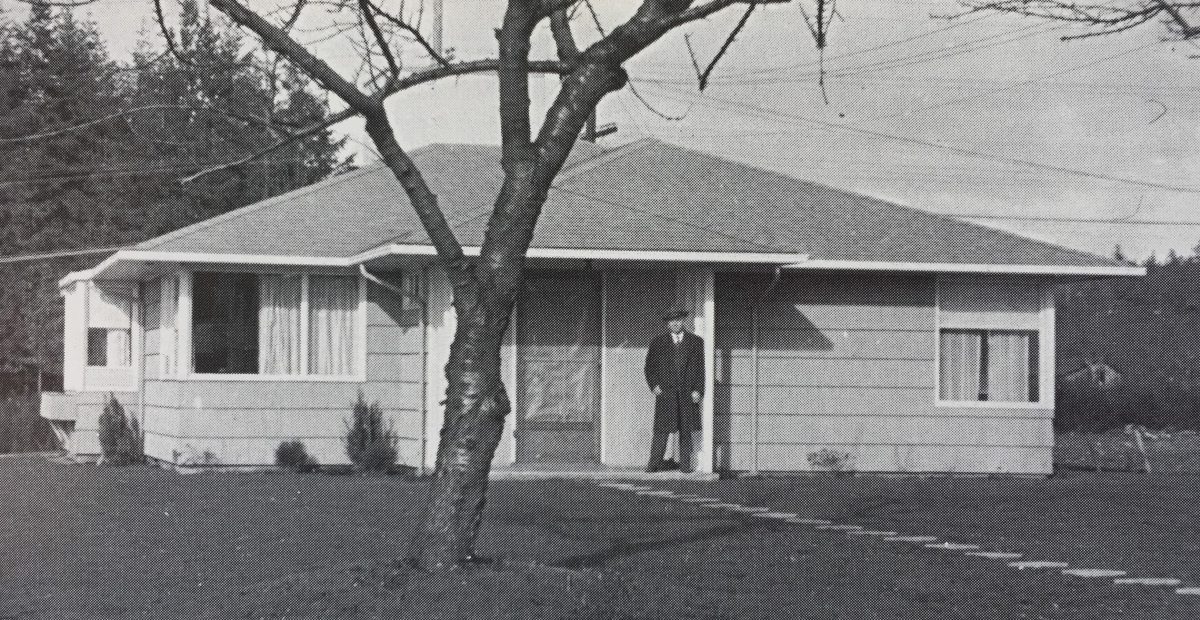
Expanding in Des Moines
On December 23, 1961, the first resident moved into the newly built Wesley Terrace building on the north side of South 216th Street. Lagging occupancy soon put the organization in financial jeopardy. People who were around at the time spoke about how the United Methodist Church’s Pacific Northwest Conference came to the rescue, naming Wesley Gardens as its first priority to receive funds from the Christian Responsibility Fund, which raised $600,000. With this loan, mortgage foreclosure on Wesley Terrace was avoided.
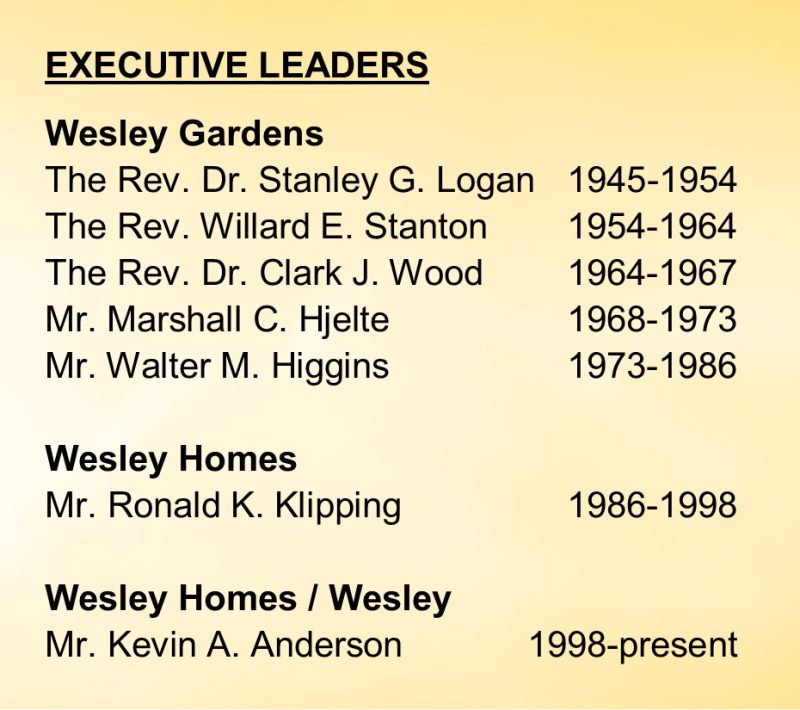
Over the first 50 years of the organization, Wesley Homes expanded on its property in Des Moines with more Cottages and a 3-story building with 15 apartments called Wesley View. In 1984, the Board purchased the neighboring EV Lutheran Good Samaritan nursing center to which a new wing was added in 1993. This created the health center that has been in operation for 31 years.
Kevin Anderson, a young nursing home administrator from Minnesota, was hired in 1998 to lead Wesley Homes. He came with a vision to grow the mission through the development of new communities and in home care services. The Board knew this was important for the organization to survive in an increasingly competitive environment and with the rapid expansion of the Seattle airport.
Looking Beyond Des Moines
Wesley Homes Board member Reverend Bill Andrews introduced Kevin, now Wesley President / CEO, to the Eby family. Norma Eby, a faithful United Methodist and supporter of Wesley Homes, was gravely ill. Her children, Jan and Leon, were considering options for the 19-acre longhorn cattle ranch their father John, then deceased, and Norma owned in Auburn. Bill showed them how Wesley would give them an ongoing legacy to their family and serve generations of other area families in the years to come. They liked the Wesley vision, and the first Wesley development outside of Des Moines was suddenly possible.
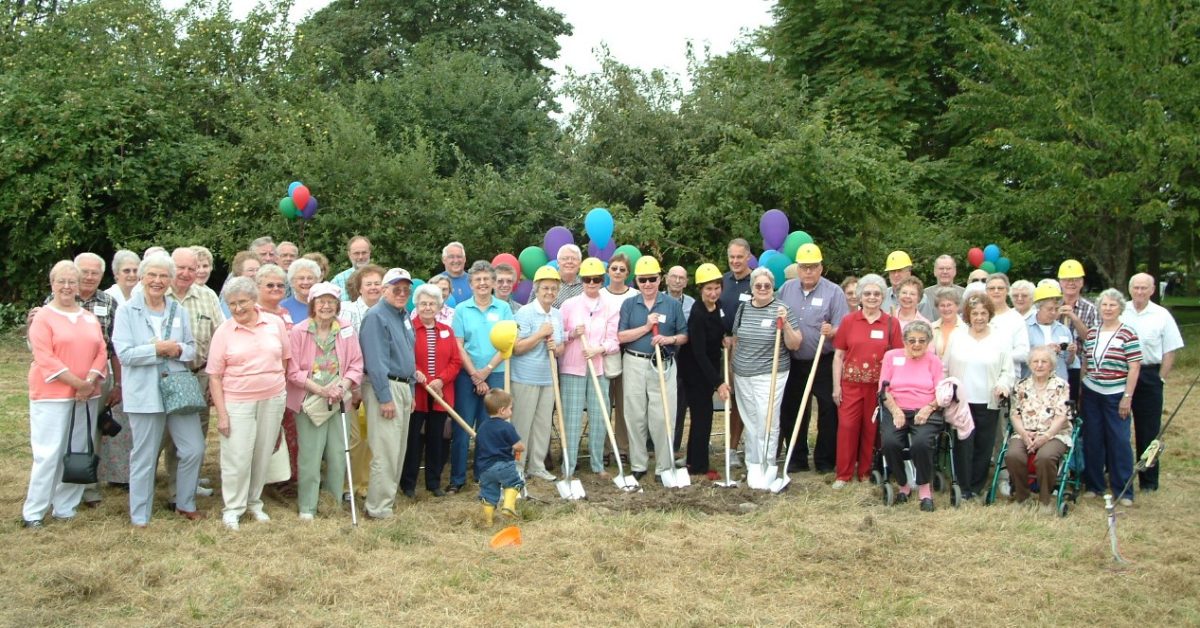
When the opportunity to build in Auburn was presented to the Board, some questioned the need for such growth and the financial risk that came with it. After all, Wesley Homes had experienced a financial crisis before. This time, the church wouldn’t be there to rescue the organization. With a unanimous vote at their meeting in September 2004, the Board of Trustees approved the development of Wesley Lea Hill in Auburn. The new community opened in 2007 followed by the rehabilitation and care center opening in 2017 and completing the continuum of care.
In 1981, the Development Department, now known as Wesley Community Foundation, was formed to help raise funds to support residents who had exhausted their financial resources through no fault of their own through the Circle of Concern fund. The Foundation embarked on its first capital campaign to help build the new Wesley Lea Hill Rehabilitation & Care Center, raising $2 million. They also raised another $1.5 million for the Lea Hill Circle of Concern fund through generous support from residents and the community.
Today, the Foundation focuses on supporting Wesley ’s active people, enriching programs and dynamic places. Along with capital campaigns and Circle of Concern, the Greatest Need fund supports resident programs such as Wesley U. The Employee Assistance fund helps staff with continuing education and emergency grants.
Adding Supportive Services
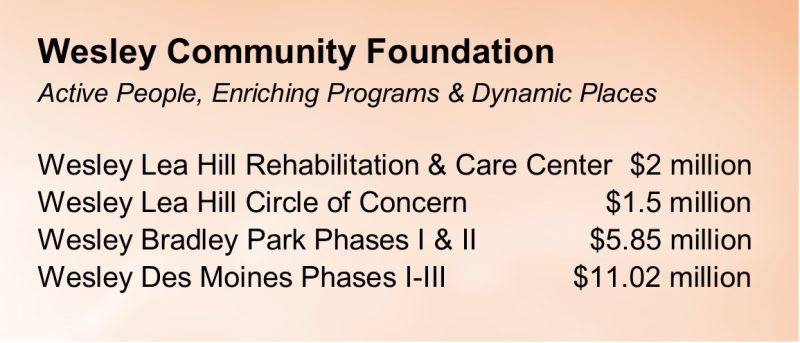
Wesley leadership realized how in-home care services could serve families in the greater communities around Wesley’s campuses. They could also be a way of offering more flexibility in the care residents received on campus. In 2003 and 2007, respectively, Wesley’s in-home care and home health divisions commenced operation. Wesley Hospice was added in King County in 2017 and in Pierce County in 2023.
Coming out of the housing crisis of 2008-2010, the leadership team sought opportunities to purchase property for future Wesley communities. Wesley found what they were looking for in Puyallup and the Fairwood neighborhood in Renton, where Wesley Spring Glen is expected to begin construction in 2025.
With a core group of dedicated supporters in Puyallup, Wesley Bradley Park was the next community on the development schedule. Lengthy permits and construction delays pushed the opening to 2019, 12 years after Wesley Lea Hill first opened. Phase II for Bradley Park is expected to begin construction in 2024 and will include the East Brownstone and the Barndt Family Rehabilitation & Care Center.
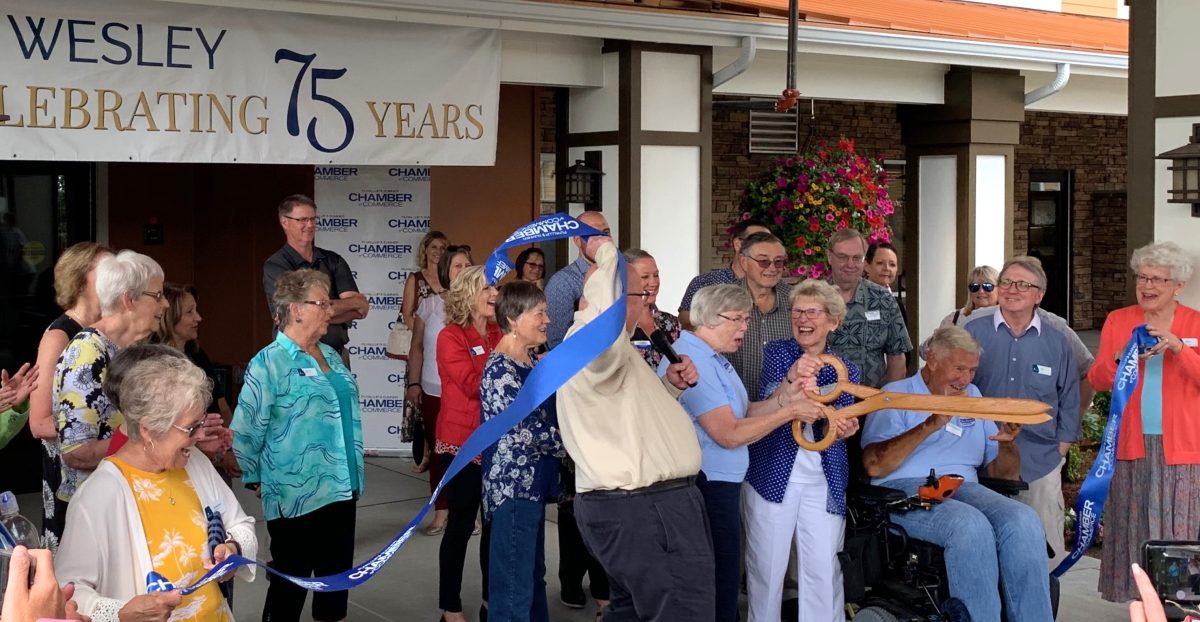
“It isn’t easy to build a new community,” said Kevin. “Or to redevelop an old one. If it were, everyone would be doing it. A real estate developer I used to know once told me that if you want to be successful in developing communities, you have to be patient. It’s a lesson I’m still trying to learn.”
Redeveloping Des Moines
In 2014, a core group from Wesley, Senior Housing Partners (part of Presbyterian Homes & Services of Minnesota), and InSite Architects came together for a two-day charrette to begin planning the redevelopment of Wesley Des Moines. Ideas had been floated before this meeting. Now it was time to commit. Occupancy was suffering, and capital expenditures for The Gardens were increasing for the 60+ year old building.
The 10-year redevelopment project at Wesley Des Moines started with renovations in The Terrace immediately followed by adding new Cottages and a Brownstone in Phase I. Working on a campus where people are living in homes that will eventually be demolished requires significant coordination and problem solving. Over 105 resident transfers occurred during the course of the redevelopment. The first wings of the new Gardens building opened as part of Phase II during the COVID pandemic. There was still enough interest that the building reached 70% occupancy within 2 months.
“We are tremendously grateful to everyone who has persevered and supported us through this time at Wesley Des Moines,” said VP of Marketing & Development Christine Tremain. “Going through a construction project requires adaptability; plans change, daily activities are disrupted and construction brings dust and noise at times. But I’ve had people tell me that they enjoy watching the construction, and they love hearing from Anthony Mizen who has been our Walsh Construction superintendent through the entire project.”
Not Resting Yet
It was an active time for Wesley with Bradley Park in Puyallup and Des Moines both under construction when another property was presented for consideration. A new master-planned community was developing between Bonney Lake and Orting called Tehaleh. It had a suitable parcel situated next to a neighborhood of 55+ homes named Trilogy. Wesley considered this to be a natural progression for future residents. To pursue this property, Wesley needed a partner. Its long-time development consultant, Presbyterian Homes & Services, was a perfect fit. Wesley at Tehaleh was developed as a 50/50 joint partnership between the organizations. It opened in 2021.
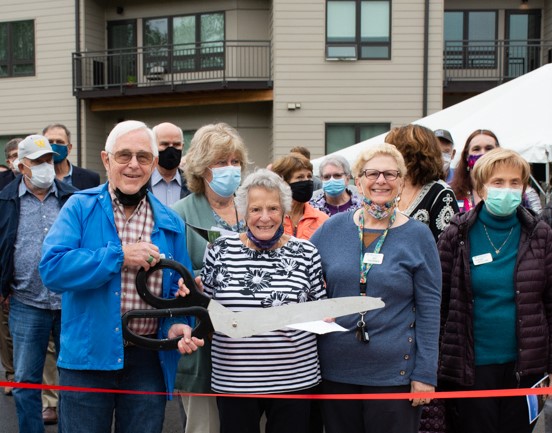
During Wesley’s 80th anniversary year of 2024, Phase III of the redevelopment of Des Moines is reaching completion. With it, the long-time dream to connect The Gardens and The Terrace buildings with a Skywalk is now a reality. Residents can easily access amenities and events across the campus more safely.
From one man’s dream 80 years ago, Wesley now serves approximately 1,300 families on its campuses. Others receive support through Wesley’s in-home care services in the greater community. Those who live at Wesley’s communities today enjoy gardening, attend classes through Wesley U, participate in fitness programs, and engage with intergenerational activities including Bezos Academy collaborations. As in the early days, Wesley is committed to its faith-based mission giving people purpose and meaning within caring communities of residents, clients, family members, and team members.
Wesley Des Moines – Wesley Community Foundation – Wesley Lea Hill – Wesley Health & Home Care – Wesley Bradley Park – Wesley at Tehaleh
